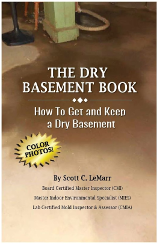Roof Discoloration from Algae
The following information is from a technical bulletin produced by the Asphalt Roofing Manufactures Assocation.
For many years, roof discoloration caused by algae has been observed throughout the United States and Canada. The discoloration usually has a brown to black appearance, and may be mistaken for fungus growth, soot, dirt, moss, or tree droppings.
Gloeocapsa magma is probably the most prevalent of several algae species that contribute to discoloration. All species are transported through the air, and tend to collect and grow upon roofing structures. Natural pigments produced by these algae may cause a white or light colored roof to gradually turn dark brown or black. Discoloration may appear as uniform discolorations or streaks. The algae discolorations should not be confused with moss or tree droppings, which typically produce only localized discolorations.
This type of roof discoloration has been most widespread in the Gulf States and along the Northwest and Eastern Seaboards. It is not, however, confined exclusively to these regions. Algae growth occurs to varying degrees in all regions of the country, especially those subjected to warm, humid conditions. It should be noted that almost all types of roofing systems are susceptible to algae discoloration. It is, of course, most readily visible upon light colored roofs, while it is not so visible upon darker shades of roofing.
Algae discolorations are difficult to remove from roofing surfaces, but may be lightened by applying a solution of liquid household chlorine bleach (sodium hypochlorite) and water. Directions for mixing solutions of these ingredients may vary among shingle manufacturers and depend on the amount of discoloration. A typical solution should be one part chlorine bleach and one part water. Other cleaning chemicals or methods should not be used without approval of the shingle manufacturer.
First, gently disperse this solution on the roofing surface. Use normal precautions for handling bleach including eye protection and rubber gloves. Be sure to apply it carefully to avoid damage to other parts of the building and the surrounding landscape. Avoid scrubbing the surface, as this friction may loosen and remove granules. If possible, always work from a ladder and/or walkboards to avoid direct contact with the roof surface. Observe all possible safety precautions when working on or near the roof. The solution should be left on the roof for at least 15 minutes but for no more than 20 minutes. Finally, rinse the solution from the roof by gently spraying the surface with water. Be warned that this solution application and rinse process will make the roof surface slippery and potentially hazardous to walk on during treatment.
The effectiveness of a cleaning technique is only temporary, and discoloration will likely reoccur. However, several types of algae resistant roofing products have been developed and are now commercially available. These asphalt roofing products are specifically designed to inhibit algae growth for extended periods of time.
Caution!
High pressure washing systems are likely to damage asphalt roofing and should not be used on asphalt roofing for removing algae or for any other purpose.
DISCLAIMER OF LIABILITY: This document was prepared by the Asphalt Roofing Manufacturers Association and is disseminated for informational purposes only. Nothing contained herein is intended to revoke or change the requirements or specifications of the individual roofing material manufacturers or local, state and federal building officials that have jurisdiction in your area. Any question, or inquiry, as to the requirements or specifications of a manufacturer, should be directed to the roofing manufacturer concerned. THE USER IS RESPONSIBLE FOR ASSURING COMPLIANCE WITH ALL APPLICABLE LAWS AND REGULATIONS.
Nothing contained herein shall be interpreted as a warranty by ARMA, either express or implied, including but not limited to the implied warranties of merchantability, fitness for a particular purpose or non-infringement. IN NO EVENT SHALL ARMA BE LIABLE FOR ANY DAMAGES WHATSOEVER, including special, indirect, consequential or incidental damages or damages for loss of profits, revenue, use or data, whether claimed in contract, tort or otherwise. Where exclusion of implied warranties is not allowed, ARMA’s liability shall be limited to the minimum scope and period permitted by law.






